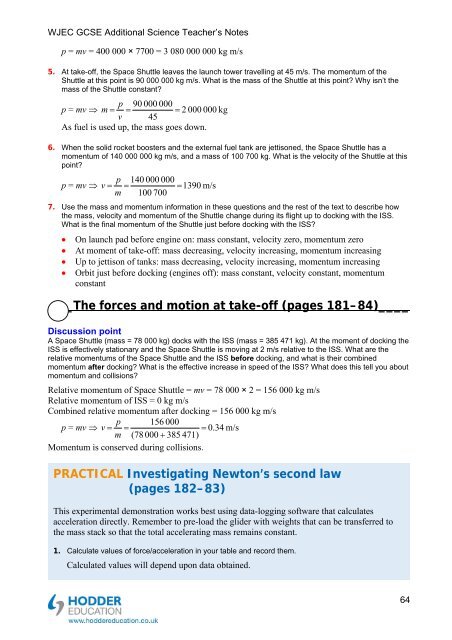Teacher's notes and answers to questions in the book - Hodder Plus ...
Teacher's notes and answers to questions in the book - Hodder Plus ...
Teacher's notes and answers to questions in the book - Hodder Plus ...
Create successful ePaper yourself
Turn your PDF publications into a flip-book with our unique Google optimized e-Paper software.
WJEC GCSE Additional Science Teacher’s Notes<br />
p = mv = 400 000 × 7700 = 3 080 000 000 kg m/s<br />
5. At take-off, <strong>the</strong> Space Shuttle leaves <strong>the</strong> launch <strong>to</strong>wer travell<strong>in</strong>g at 45 m/s. The momentum of <strong>the</strong><br />
Shuttle at this po<strong>in</strong>t is 90 000 000 kg m/s. What is <strong>the</strong> mass of <strong>the</strong> Shuttle at this po<strong>in</strong>t Why isn’t <strong>the</strong><br />
mass of <strong>the</strong> Shuttle constant<br />
p 90 000 000<br />
p = mv m 2 000 000 kg<br />
v 45<br />
As fuel is used up, <strong>the</strong> mass goes down.<br />
6. When <strong>the</strong> solid rocket boosters <strong>and</strong> <strong>the</strong> external fuel tank are jettisoned, <strong>the</strong> Space Shuttle has a<br />
momentum of 140 000 000 kg m/s, <strong>and</strong> a mass of 100 700 kg. What is <strong>the</strong> velocity of <strong>the</strong> Shuttle at this<br />
po<strong>in</strong>t<br />
p = mv <br />
p 140 000 000<br />
v <br />
1390<br />
m/s<br />
m 100 700<br />
7. Use <strong>the</strong> mass <strong>and</strong> momentum <strong>in</strong>formation <strong>in</strong> <strong>the</strong>se <strong>questions</strong> <strong>and</strong> <strong>the</strong> rest of <strong>the</strong> text <strong>to</strong> describe how<br />
<strong>the</strong> mass, velocity <strong>and</strong> momentum of <strong>the</strong> Shuttle change dur<strong>in</strong>g its flight up <strong>to</strong> dock<strong>in</strong>g with <strong>the</strong> ISS.<br />
What is <strong>the</strong> f<strong>in</strong>al momentum of <strong>the</strong> Shuttle just before dock<strong>in</strong>g with <strong>the</strong> ISS<br />
<br />
<br />
<br />
<br />
On launch pad before eng<strong>in</strong>e on: mass constant, velocity zero, momentum zero<br />
At moment of take-off: mass decreas<strong>in</strong>g, velocity <strong>in</strong>creas<strong>in</strong>g, momentum <strong>in</strong>creas<strong>in</strong>g<br />
Up <strong>to</strong> jettison of tanks: mass decreas<strong>in</strong>g, velocity <strong>in</strong>creas<strong>in</strong>g, momentum <strong>in</strong>creas<strong>in</strong>g<br />
Orbit just before dock<strong>in</strong>g (eng<strong>in</strong>es off): mass constant, velocity constant, momentum<br />
constant<br />
_The forces <strong>and</strong> motion at take-off (pages 181–84)____<br />
Discussion po<strong>in</strong>t<br />
A Space Shuttle (mass = 78 000 kg) docks with <strong>the</strong> ISS (mass = 385 471 kg). At <strong>the</strong> moment of dock<strong>in</strong>g <strong>the</strong><br />
ISS is effectively stationary <strong>and</strong> <strong>the</strong> Space Shuttle is mov<strong>in</strong>g at 2 m/s relative <strong>to</strong> <strong>the</strong> ISS. What are <strong>the</strong><br />
relative momentums of <strong>the</strong> Space Shuttle <strong>and</strong> <strong>the</strong> ISS before dock<strong>in</strong>g, <strong>and</strong> what is <strong>the</strong>ir comb<strong>in</strong>ed<br />
momentum after dock<strong>in</strong>g What is <strong>the</strong> effective <strong>in</strong>crease <strong>in</strong> speed of <strong>the</strong> ISS What does this tell you about<br />
momentum <strong>and</strong> collisions<br />
Relative momentum of Space Shuttle = mv = 78 000 × 2 = 156 000 kg m/s<br />
Relative momentum of ISS = 0 kg m/s<br />
Comb<strong>in</strong>ed relative momentum after dock<strong>in</strong>g = 156 000 kg m/s<br />
p 156 000<br />
p = mv v <br />
0.34 m/s<br />
m (78 000 385 471)<br />
Momentum is conserved dur<strong>in</strong>g collisions.<br />
PRACTICAL Investigat<strong>in</strong>g New<strong>to</strong>n’s second law<br />
(pages 182–83)<br />
This experimental demonstration works best us<strong>in</strong>g data-logg<strong>in</strong>g software that calculates<br />
acceleration directly. Remember <strong>to</strong> pre-load <strong>the</strong> glider with weights that can be transferred <strong>to</strong><br />
<strong>the</strong> mass stack so that <strong>the</strong> <strong>to</strong>tal accelerat<strong>in</strong>g mass rema<strong>in</strong>s constant.<br />
1. Calculate values of force/acceleration <strong>in</strong> your table <strong>and</strong> record <strong>the</strong>m.<br />
Calculated values will depend upon data obta<strong>in</strong>ed.<br />
64

















